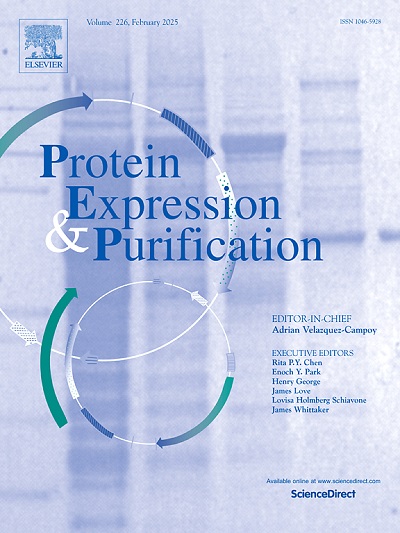Differentially labeled flaviviral protease-cofactor complex for NMR spectroscopic applications
IF 1.2
4区 生物学
Q4 BIOCHEMICAL RESEARCH METHODS
引用次数: 0
Abstract
Flaviviruses such as Dengue, Zika and West-Nile viruses have a positive strand RNA genome which is translated to a polyprotein inside the host cell. The viral polypeptide is matured to its constituents by the enzymatic action of NS2B-NS3 protease-cofactor complex. The flaviviral protease-cofactor complex attracted a lot of interest recently because of its potential for therapeutic intervention and the unique nature of catalysis where the peptide cofactor regulates the enzymatic activity. Obtaining the enzyme and cofactor differentially labeled with naturally abundant nuclei and NMR active nuclei respectively will be helpful in reducing the spectral complexity by making the enzyme invisible in a multidimensional NMR spectrum while only showing peaks from the cofactor. This will enable one to study the properties of the cofactor in isolation using NMR spectroscopy. Here, I have used a strategy for selectively labeling the cofactor within the complex with NMR active nuclei while peaks from the enzyme were rendered invisible. The protocol used here takes advantage of an ‘on-column unfolding’ step during the initial Ni-NTA chromatography to separate the enzyme and cofactor in unfolded conditions. The labeled cofactor was then allowed to fold in the presence of an unlabeled enzyme to obtain a differently labeled complex. We compared the 1H-15N HSQC spectrum of the differently labeled, wild type and free cofactor to ensure that the cofactor attained the desired fold within the complex. The protocol is scalable, inexpensive and can be applied to other two-component enzyme systems where a peptide cofactor is essential for the folding of an enzyme.
核磁共振波谱应用的差异标记黄病毒蛋白酶辅因子复合物
登革热、寨卡和西尼罗河病毒等黄病毒具有正链RNA基因组,可在宿主细胞内翻译成多蛋白。病毒多肽通过NS2B-NS3蛋白酶-辅因子复合物的酶促作用成熟为其组成成分。黄病毒蛋白酶-辅助因子复合物由于其治疗干预的潜力和肽辅助因子调节酶活性的独特催化性质,最近引起了人们的极大兴趣。将酶和辅因子分别标记为天然丰富核和核磁共振活性核,使酶在多维核磁共振谱中不可见,而只显示辅因子的峰,有助于降低谱的复杂性。这将使人们能够使用核磁共振波谱法研究分离的辅因子的性质。在这里,我使用了一种策略,选择性地用核磁共振活性核标记复合体内的辅因子,同时使酶的峰不可见。这里使用的方案在初始Ni-NTA色谱中利用“柱上展开”步骤在未展开的条件下分离酶和辅因子。然后允许标记的辅因子在未标记的酶存在下折叠,以获得不同标记的复合物。我们比较了不同标记、野生型和游离辅因子的h - 15n HSQC谱,以确保辅因子在复合体内达到所需的折叠。该方案可扩展,价格低廉,可应用于其他双组分酶系统,其中肽辅因子是酶折叠所必需的。
本文章由计算机程序翻译,如有差异,请以英文原文为准。
求助全文
约1分钟内获得全文
求助全文
来源期刊

Protein expression and purification
生物-生化研究方法
CiteScore
3.70
自引率
6.20%
发文量
120
审稿时长
32 days
期刊介绍:
Protein Expression and Purification is an international journal providing a forum for the dissemination of new information on protein expression, extraction, purification, characterization, and/or applications using conventional biochemical and/or modern molecular biological approaches and methods, which are of broad interest to the field. The journal does not typically publish repetitive examples of protein expression and purification involving standard, well-established, methods. However, exceptions might include studies on important and/or difficult to express and/or purify proteins and/or studies that include extensive protein characterization, which provide new, previously unpublished information.
 求助内容:
求助内容: 应助结果提醒方式:
应助结果提醒方式:


